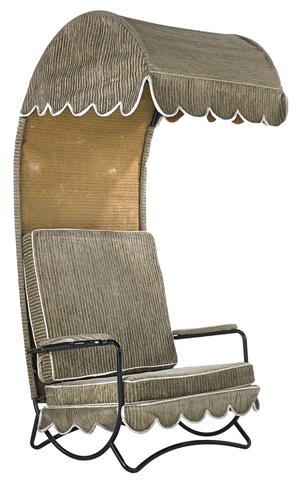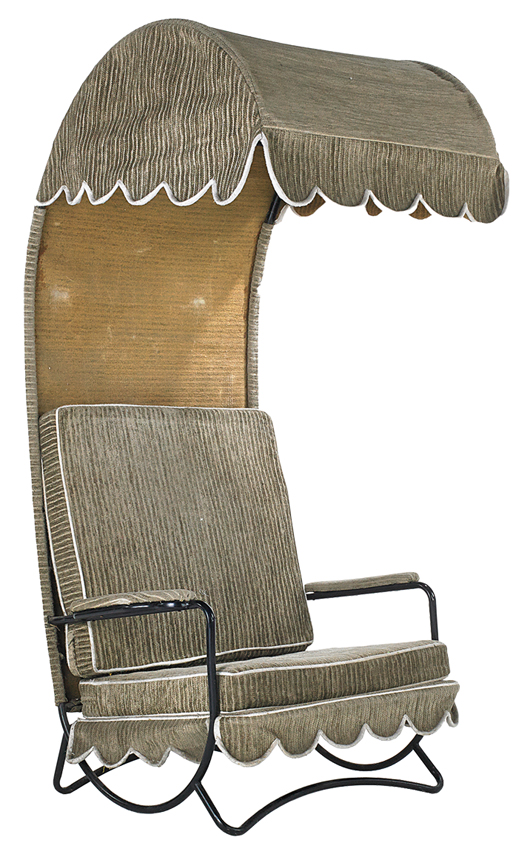
BEACHWOOD, Ohio – A chair has four legs, a seat, a back and perhaps arms—or at least that was the rule for hundreds of years. Do you ever stop to think about chairs?
Before the 16th century, only the king, the church hierarchy or the most important person in the room sat on a chair. Others stood or used stools or benches. And, of course, since chairs represented authority, they were large, ornate and often gilded. In fact, the more important the person, the taller the chair back and the more extravagant the chair’s decorations.
The symbolism has been retained in our language: a “chair” presides over a meeting, and the “first chair” in the orchestra has an important job.
By the 16th century, wooden chairs were “downgraded” to furniture for everyone, and styles began to be updated about every 25 years. By Victorian times, there was a chair for each person who sat at the dinner table, and soon sets of chairs were sold. In the late 19th century, technology spurred new ideas and unusual chairs. Some chairs could fold, turn into beds, recline, swivel or be converted to wheelchairs. Other chairs were made to fit into a corner. Updated ideas about work, play and children required dental chairs, office chairs, beach chairs, massage chairs, barber chairs and highchairs. By the 20th century, wood was not the only material used to make chairs. Frames were made of iron, steel, aluminum and other metals, as well as plastic, plywood, cardboard, webbing and foam rubber. So, chairs no longer necessarily had four legs, a seat and a back, but were cone-shape, egg-shape, zigzag, an asymmetrical blob or even a plastic bubble hung by a chain. Strange, but a place to sit.
In 1959 Jean Royere of France made a canopy lounge chair of enameled steel and corduroy for the daughter of the Shah of Iran, Princess Shahnaz. The chair back was 70 inches high and curved forward to make a roof to protect her from sun or rain. It had bent metal arms and short legs that kept the chair just a little above the ground so she could lounge with her legs extended. The chair sold in 2013 for $21,250 at Rago Arts and Auction Center in New Jersey, even though it was worn and soiled.
Very extreme modern chairs in unusual designs and materials sell today for tens of thousands of dollars. Most are great to look at but uncomfortable to use. The modern chair is sometimes just a piece of sculpture without a job.
Q: I have a 12-inch folding ruler that advertises International Harvester Co. of America. It’s made of cream-colored celluloid and has two calendars on the back, one for 1906 and the other for 1907. The front ad reads, “Make it a Rule to bale your hay with I.H.C. Hay Presses.” Does it have any value?
A: International Harvester Co., headquartered in Chicago, was in business from 1902 to 1985. Advertising with giveaways like rulers, mirrors, calendars, paperweights and other small items has been popular since the late 1800s. Your ruler would appeal to collectors of advertising or of celluloid, an early plastic. But rulers like yours don’t sell for a lot of money. We have seen them offered for $10 to $25.
Q: My antique railroad lantern is marked “Thompson’s Pat. April 27, 1869” on the back. It’s marked “Pacific” on the front. What’s it worth?
A: Railroad lanterns are favorites of collectors of “railroadiana” (railroad antiques and collectibles). Nathan Thompson of Brooklyn, N.Y., received a patent for his “lantern improvement” in 1869. His lantern was produced for years and was purchased by many different railroad companies. The Pacific Railroad, chartered by Missouri in 1849, was reorganized in 1872 as the Missouri Pacific Railway. So it’s likely that your lantern was manufactured in the early 1870s. A Thompson Patent lantern like yours auctioned last fall for $143.
Q: I have an old 4-inch-diameter glass ashtray surrounded by a 7-inch-diameter rubber tire. Both sides of the tire are embossed “U.S. Royal” and “U.S. Heavy Duty Six.” Was this an advertising item? What is its value?
A: Your ashtray was indeed an advertising item. Ashtrays like it were made from the 1930s into the ’60s to advertise just about every American tire manufacturer, including U.S. Royal, Firestone, Goodyear and Goodrich. If yours is in great shape, an advertising collector might pay about $40 for it.
Q: I have a vase stamped “Made in German Democratic Republic.” It’s also stamped “J.L. Menau” and, underneath it, “Kenneberg-Torzellan.” Can you tell me who made this vase?
A: Your vase was made by a porcelain factory in Ilmenau, Thuringia, Germany. Although the name of the town looks like “JLMENAU” on some marks, it is actually “Ilmenau,” and what looks like “Kenneberg-Torzellan” actually is “Henneberg-Porzellan.” The factory was founded in Ilmenau in 1777 and was operated under various names and owners. It became Ilmenauer Porzellanfabrik Graf von Henneberg in 1930. The company was nationalized when Ilmenau became part of the Germany Democratic Republic (East Germany) after World War II. It operated as V.E.B. Henneberg Porzellan Ilmenau from 1949 until 1990. Your vase was made during this period. The company went bankrupt in 2002, and the assets were bought by an investor, who changed the company’s name to Neue Porzellanfabrik Ilmenau. The maker is not well known, so your vase is worth about $30.
Tip: Put a small rug or dropcloth under a piece of furniture to move it. Pull the rug to slide the furniture across the room. This protects the furniture and floor. But don’t try this on a high-pile carpet.
Need prices for collectibles? Find them at Kovels.com, our website for collectors. More than 84,000 prices and 5,000 color pictures have just been added. Now you can find more than 856,000 prices that can help you determine the value of your collectible. Access to the prices is free at Kovels.com/priceguide.
Terry Kovel answers as many questions as possible through the column. By sending a letter with a question, you give full permission for use in the column or any other Kovel forum. Names, addresses or email addresses will not be published. We cannot guarantee the return of any photograph, but if a stamped envelope is included, we will try. The volume of mail makes personal answers or appraisals impossible. Write to Kovels, Auction Central News, King Features Syndicate, 300 W. 57th St., New York, NY 10019.
CURRENT PRICES
Current prices are recorded from antiques shows, flea markets, sales and auctions throughout the United States. Prices vary in different locations because of local economic conditions.
- Pickard pitcher, gilt, porcelain, c. 1960, 7 1/2 inches, $45.
- Gouda vase, Noda pattern, flowers, multicolored, c. 1920, 7 3/4 inches, pair, $180.
- Candlestick, Whippet dog, seated, holding torch, patinated metal, 13 x 7 2/3 inches, pair, $325.
- Asco Hot Nut dispensing machine, coin-operated, cup attachment, 23 inches, $330.
- Cast-iron doorstop, two cats standing, painted, Hubley, c. 1910, 7 inches, $355.
- Pepsi-Cola sign, “America’s Biggest Nickel’s Worth, 5 cents,” tin lithograph, red, white, blue, 1940s, 10 x 30 inches, $550.
- Irish Mail quadracycle, wood, Hill Standard, Indiana, c. 1910, $660.
- Daum vase, bulbous, textured, indented sides, flowers, dragonflies, gold enamel, pink ground, 3 x 5 1/2 inches, $1,875.
- Gothic Revival nesting tables, rosewood, carved, pierced, splayed scrolled feet, c. 1850, 29 inches, 2 pieces, $2,390.
- Goddess marble bust, wearing helmet, Hellenistic style, mounted, iron support, 20 x 10 inches, $2,870.
Available now: The best book to own if you want to buy, sell or collect. And if you order now, you’ll receive a copy with the author’s autograph. The new Kovels’ Antiques & Collectibles Price Guide, 2013, 45th edition, is your most accurate source for current prices. This large-size paperback has more than 2,500 color photographs and 40,000 up-to-date prices for more than 775 categories of antiques and collectibles. You’ll also find hundreds of factory histories and marks, a report on the record prices of the year, plus helpful sidebars and tips about buying, selling, collecting and preserving your treasures. Available online at Kovelsonlinestore.com; by phone at 800-303-1996; at your bookstore; or send $27.95 plus $4.95 postage to Price Book, Box 22900, Beachwood, OH 44122.
© 2013 by Cowles Syndicate Inc.
This lounge chair, probably one of a kind, was made for royalty in 1959 by the famous French designer Jean Royere. It must have been made to be used near a swimming pool or on a beach. It sold at a 2013 Rago Arts auction in Lambertville, N.J., for $21,250.

ADDITIONAL IMAGE OF NOTE



